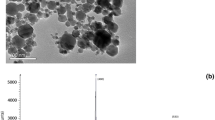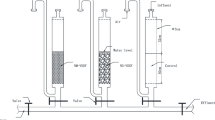Abstract
Molybdenum (Mo) concentrations in mining-impacted water can be orders of magnitude higher than health-based values for drinking water. Mo in oxidized mine waters is predominantly present as the oxyanion molybdate, which is problematic in mine water treatment because it is not removed by conventional alkaline addition treatment and requires separate Mo-specific methods. Mo removal by sorption to ferric precipitates is the typical treatment strategy. We investigated a sustainable alternative for a mine water with low-iron content and high manganese (Mn). We evaluate the potential for Mo removal by sorption onto Mn-rich sludge from a mine water treatment plant that uses lime to remove metals at pH 10. In laboratory sorption batch tests with an initial Mo concentration of 10 mg/L in a sodium chloride solution, over 90% of the Mo was removed onto the sludge at pH 6 and below (up to 34 mg Mo/g Mn). Sorption was sensitive to pH, with sharp decreases in sorption levels from pH 6 to 8. Sorption was also affected by the matrix composition of the mine water samples, apparently due to competitive sorption from other ions in the mine water. Use of site Mn for water treatment provides a more sustainable treatment approach; however, additional knowledge is required to understand the effects of site-specific complexities.
Resumen
Las concentraciones de molibdeno (Mo) en las aguas afectadas por la minería pueden ser algunos órdenes de magnitud superiores a los valores sanitarios para el agua potable. El Mo en las aguas mineras oxidadas está presente predominantemente como el oxianión molibdato, que presenta complicaciones durante el tratamiento del agua minera porque no se elimina con el tratamiento convencional de adición alcalina y requiere métodos separados específicos para el Mo. La eliminación de Mo mediante sorción en precipitados férricos es la estrategia de tratamiento típica. Investigamos una alternativa sostenible para un agua de mina con bajo contenido en hierro y alto en manganeso (Mn). Evaluamos el potencial de eliminación de Mo por sorción en lodos ricos en Mn procedentes de una planta de tratamiento de aguas de mina que utiliza cal para eliminar metales a pH 10. En pruebas de sorción en laboratorio con una concentración inicial de Mo de 10 mg/L en una solución de cloruro de sodio, más del 90% del Mo se eliminó en el lodo a pH 6 y por debajo (hasta 34 mg Mo/g Mn). La sorción fue sensible al pH, con fuertes descensos en los niveles de sorción desde el pH 6 al 8. La sorción también se vio afectada por la composición de la matriz de las muestras de agua de la mina, aparentemente debido a la sorción competitiva de otros iones en el agua de la mina. El uso del Mn del emplazamiento para el tratamiento del agua proporciona un enfoque de tratamiento más sostenible; sin embargo, se requieren conocimientos adicionales para comprender los efectos de las complejidades específicas del emplazamiento.
含锰污泥吸附去除受采矿影响废水中钼的方法
受采矿影响水体的钼(Mo)浓度可能比饮用水健康标准高几个数量级.钼在氧化环境的矿井水中主要以钼酸盐阴离子的形式存在, 不能为常规的加碱水处理方法所去除,还需再用特定的钼去除方法分开处理,给矿井水处理带来了困难.用铁沉淀物吸附处理是去除钼的典型方案.研究用低铁和高锰的可持续替代物来处理矿井水.评价了矿井水处理厂含锰污泥的钼(Mo)吸附去除潜力, 水处理厂在pH = 10的条件下用石灰去除污水金属.在实验室吸附批处理试验中,氯化钠溶液的钼(Mo)初始浓度10 mg/L,pH值小于6,超过90%的Mo被污泥吸附去除 (达34 mg Mo/g Mn).吸附对pH值很敏感,pH值从 6到8时,吸附水平也急剧下降.吸附还受矿井水样品的基本成分影响, 显然是因矿井水中其它离子具有竞争吸附作用.利用现场含锰产物进行水处理是—种更可持续的处理方法;然而,还需要更多地了解现场复杂性的影响.



Similar content being viewed by others
References
Aguiar AO, Duarte RA, Ladeira ACQ (2013) The application of MnO2 in the removal of manganese from acid mine water. Water Air Soil Pollut 224:1–8. https://doi.org/10.1007/s11270-013-1690-2
Ardau C, Frau F, Ricci PC et al (2011) Synthetic and natural Zn-Al sulphate LDHs for removal of As(V) from NAMD. In: Rüde TR, Freund A, Wolkersdorfer C (eds), In: Proc, 11th International Mine Water Assoc (IMWA) Congress - Mine Water - Managing the Challenges, Aachen, Germany, pp 559–562
Ardau C, Frau F, Dore E, Lattanzi P (2012) Molybdate sorption by Zn-Al sulphate layered double hydroxides. Appl Clay Sci 65–66:128–133. https://doi.org/10.1016/j.clay.2012.05.005
Atkins M, Glasser FP, Kindness A (1992) Cement hydrate phase: solubility at 25°C. Cem Concr Res 22:241–246
ATSDR (Agency for Toxic Substances and Disease Registry) (2020) Toxicological Profile for Molybdenum, U.S. Dept of Health and Human Services
Aubé B, Stroiazzo J (2000) Molybdenum Treatment at Brenda Mines. In: Proc, 5th International Conf on Acid Rock Drainage (ICARD), Soc for Mining, Metallurgy and Exploration, Inc (SME), Littleton, CO
Aubé B, Vergara A (2010) Molybdenum Treatment at Codelco El Teniente Mine. Presented at 17th British Columbia MEND Metal Leaching/Acid Rock Drainage Workshop, Vancouver
Balistrieri LS, Chao TT (1990) Adsorption of selenium by amorphous iron oxyhydroxide and manganese dioxide. Geochim Cosmochim Acta 54:739–751. https://doi.org/10.1016/0016-7037(90)90369-V
CCME (Canadian Council of Ministers of the Environment) (1999) Canadian Water Quality Guidelines for the Protection of Aquatic Life: Molybdenum
Conlan MJW (2009) Attenuation Mechanisms for Molybdenum in Neutral Rock Drainage. PhD Diss, The Univ of British Columbia
Conlan MJW, Mayer KU, Blaskovich R, Beckie RD (2012) Solubility controls for molybdenum in neutral rock drainage. Geochem Explor Environ Anal 12:21–32. https://doi.org/10.1144/1467-7873/10-RA-043
Cui M, Luther GW, Gomes M (2021) Cycling of W and Mo species in natural sulfidic waters and their sorption mechanisms on MnO2 and implications for paired W and Mo records as a redox proxy. Geochim Cosmochim Acta 295:24–48. https://doi.org/10.1016/j.gca.2020.12.007
Das S, Jim Hendry M (2013) Adsorption of molybdate by synthetic hematite under alkaline conditions: effects of aging. Appl Geochemistry 28:194–201. https://doi.org/10.1016/j.apgeochem.2012.10.032
Davantès A, Lefèvre G (2015) In situ characterization of (poly)molybdate and (poly)tungstate ions sorbed onto iron (hydr)oxides by ATR-FTIR spectroscopy. Eur Phys J Spec Top 224:1977–1983. https://doi.org/10.1140/epjst/e2015-02514-8
Della Puppa L, Komárek M, Bordas F et al (2013) Adsorption of copper, cadmium, lead and zinc onto a synthetic manganese oxide. J Colloid Interface Sci 399:99–106. https://doi.org/10.1016/j.jcis.2013.02.029
Elzinga EJ, Kretzschmar R (2013) In situ ATR-FTIR spectroscopic analysis of the co-adsorption of orthophosphate and Cd(II) onto hematite. Geochim Cosmochim Acta 117:53–64. https://doi.org/10.1016/j.gca.2013.04.003
Essington ME (1990) Calcium molybdate solubility in spent oil shale and a preliminary evaluation of the association constants for the formation of CaMoO40(aq), KMoO4−(aq), and NaMoO4−(aq). Environ Sci Technol 24:214–220. https://doi.org/10.1021/es00072a010
Freitas RM, Perilli TAG, Ladeira ACQ (2013) Oxidative precipitation of manganese from acid mine drainage by potassium permanganate. J Chem. https://doi.org/10.1155/2013/287257
Goldberg S, Chunming S, Forster HS (1998) Sorption of molybdenum on oxides, clay minerals, and soils: mechanisms and models. In: Jenne E (ed) Adsorption of Metals by Geomedia. Academic Press, San Diego, pp 401–426
Goldberg S, Johnston CT, Suarez DL, Lesch SM (2008) Mechanism of molybdenum adsorption on soils and soil minerals evaluated using vibrational spectroscopy and surface complexation modeling. In: Kent DB (ed) Barnett MO. Developments in Earth and Environmental Sciences, Elsevier BV, pp 235–266
Hach Company (2019) Method 8036, Molybdenum, HR, Mercaptoacetic Acid Method, DOC316.53.01061
Hohl H, Sigg L, Stumm W (1980) Characterization of surface chemical properties of oxides in natural water; the role of specific adsorption determining the specific charge. In: Kavanaugh MC, Leckie JO (eds) Particles in Water. American Chemical Soc, Washington DC, pp 1–31
Kosmulski M (2009) Compilation of PZC and IEP of sparingly soluble metal oxides and hydroxides from literature. Adv Colloid Interface Sci 152:14–25. https://doi.org/10.1016/j.cis.2009.08.003
Kung HH (1989) Transition metal oxides - surface chemistry and catalysis. Stud Surf Sci Catal 45:6–26
LeGendre GR, Runnells DD (1975) Removal of dissolved molybdenum from wastewaters by precipitates of ferric iron. Environ Sci Technol 9:744–749. https://doi.org/10.1021/es60106a010
Ludington BS, Plumlee GS, (2009) Climax-type porphyry molybdenum deposits. U.S. Geological Survey Open-File Report 2009-1215:1–16
Matern K, Mansfeldt T (2015) Molybdate adsorption by birnessite. Appl Clay Sci 108:78–83. https://doi.org/10.1016/j.clay.2015.01.024
Morrison SJ, Mushovic PS, Niesen PL (2006) Early breakthrough of molybdenum and uranium in a permeable reactive barrier. Environ Sci Technol 40:2018–2024. https://doi.org/10.1021/es052128s
Murray JW (1975) The interaction of metal ions at the manganese dioxide-solution interface. Geochim Cosmochim Acta 39:505–519. https://doi.org/10.1016/0016-7037(75)90103-9
Murray JW, Dillard JG, Giovanoli R et al (1985) Oxidation of Mn(II): Initial mineralogy, oxidation state and ageing. Geochim Cosmochim Acta 49:463–470. https://doi.org/10.1016/0016-7037(85)90038-9
Post JE (1999) Manganese oxide minerals: Crystal structures and economic and environmental significance. Proc Natl Acad Sci USA 96:3447–3454. https://doi.org/10.1073/pnas.96.7.3447
Schindler PW, Stumm W (1987) The surface chemistry of oxides, hydroxides, and oxide minerals. In: Stumm W (ed) Aquatic Surface Chemistry. Wiley, New York, pp 83–110
Sencza W (2013) Golden giant mine closure. Presented at 20th British Columbia MEND Metal Leaching/Acid Rock Drainage Workshop. Vancouver
Skierszkan EK, Mayer KU, Weis D, Beckie RD (2016) Molybdenum and zinc stable isotope variation in mining waste rock drainage and waste rock at the Antamina mine, Peru. Sci Total Environ 550:103–113. https://doi.org/10.1016/j.scitotenv.2016.01.053
Smedley PL, Cooper DM, Lapworth DJ (2014) Molybdenum distributions and variability in drinking water from England and Wales. Environ Monit Assess 186:6403–6416. https://doi.org/10.1007/s10661-014-3863-x
Smedley PL, Kinniburgh DG (2017) Molybdenum in natural waters: a review of occurrence, distributions and controls. Appl Geochem 84:387–432. https://doi.org/10.1016/j.apgeochem.2017.05.008
Smith KS (1999) Metal sorption on mineral surfaces: an overview with examples relating to mineral deposits. In: Plumlee GS, Logsdon MJ (eds) The Environmental Geochemistry of Mineral Deposits, Part A: Process, Techniques, and Health Issues. Society of Economic Geologists, Littleton, CO, pp 161–182
Stumm W, Morgan JJ (1996) Aquatic Chemistry: Chemical Equilibria and Rates in Natural Waters, 3rd edn. John Wiley & Sons Inc, New York
ThermoChimie Partners (2018) ThermoChimie database version 10a for PHREEQC (Version 3.3.7–11094) and GWB (11.0.4)
USEPA (U.S. Environmental Protection Agency) (2007) Method 3051A (SW-846): Microwave Assisted Acid Digestion of Sediments, Sludges, and Oils, Revision 1, Washington, DC
USEPA (2018) 2018 Edition of the Drinking Water Standards and Health Advisories Tables
United Nations (2015) Transforming our world: the 2030 Agenda for Sustainable Development, Resolution adopted by the General Assembly on 25 Sep 2015
WHO (World Health Organization) (2017) Guidelines for drinking-water quality: fourth edition, incorporating the first addendum. https://www.who.int/publications/i/item/9789241549950. Accessed 15 Mar 2022
Xu N, Braida W, Christodoulatos C, Chen J (2013) A review of molybdenum adsorption in soils/bed sediments: speciation, mechanism, and model applications. Soil Sediment Contam 22:912–929. https://doi.org/10.1080/15320383.2013.770438
Yan Y, Wan B, Mansor M et al (2022) Co-sorption of metal ions and inorganic anions/organic ligands on environmental minerals: a review. Sci Total Environ 803:149918. https://doi.org/10.1016/j.scitotenv.2021.149918
Zaman MI, Mustafa S, Khan S, Xing B (2009) Effect of phosphate complexation on Cd2+ sorption by manganese dioxide (β-MnO2). J Colloid Interface Sci 330:9–19. https://doi.org/10.1016/j.jcis.2008.10.053
Zhang M, Reardon EJ (2003) Removal of B, Cr, Mo, and Se from wastewater by incorporation into hydrocalumite and ettringite. Environ Sci Technol 37:2947–2952. https://doi.org/10.1021/es020969i
Zhao Z, Liu J, Xia W, Cao C, Chen X, Huo G, Chen A, Li H (2009) Removal of molybdenum from MnSO4 solution with freshly precipitated “nascent” Mn3O4. Hydrometallurgy 99:67–71. https://doi.org/10.1016/j.hydromet.2009.06.008
Zhao S, Li C, Liu P, Huang R, Saad EM, Tang Y (2018) Zinc presence during mineral formation affects the sorptive reactivity of manganese oxide. Soil Syst 2:1–13. https://doi.org/10.3390/soilsystems2020019
Zinck JM, Hogan CM, Griffith WF, Laflamme JHG (1999) The effect of process parameters and aging on lime sludge density and stability. MEND Report 3(42):2b
Acknowledgements
The authors thank the mine staff for providing sludge and water samples for use in this research.
Author information
Authors and Affiliations
Corresponding author
Rights and permissions
About this article
Cite this article
Doyle, S., Figueroa, L. Removal of Molybdenum from Mining-Impacted Water by Sorption onto Manganese-Rich Sludge. Mine Water Environ 41, 721–730 (2022). https://doi.org/10.1007/s10230-022-00893-4
Received:
Accepted:
Published:
Issue Date:
DOI: https://doi.org/10.1007/s10230-022-00893-4




